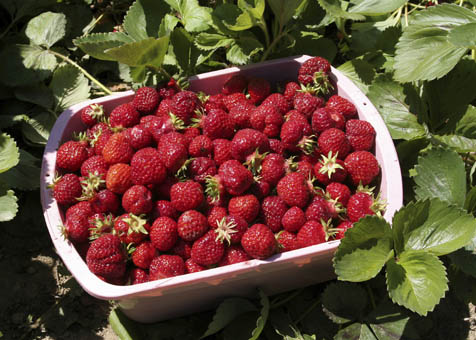
In a county that boasts strawberries as one of its largest commercial crops, it might seem ridiculous to suggest that you grow your own at home. But if you’ve ever eaten a freshly picked strawberry as you wandered down the garden row, you will know there is a great difference between store-bought and home-grown in flavor, juiciness, and color. Industrial agricultural operations also rely heavily on fungicides and other treatments to keep their plants in top shape, practices that most of us shun.
While strawberries can be planted in spring, fall is also a great time to get them established. Planting in the next month will result in more fruit instead of excess foliage next season. Many strawberries also like a bit of winter chill, so planting now will get them a head start in that area as well. Strawberries like evenly moist soil; if your garden is well-drained, plant them in rows about two feet apart and space plants 14-18 inches apart. If your soil stays soggy, then make raised mounds to plant on. Plants may be available locally soon, but if not, go online to get them shipped to you. The bare root plants need to be kept damp and planted as soon as possible. Be sure to plant with crowns exposed. If they are covered with soil, they will rot. Mulch between plants and rows to conserve moisture, keep weeds down, and fruit-which develops near the soil-clean.
Strawberry plants spread by runners and there are all sorts of methods of treatment of the little plants that develop at their ends. If you want the mother plant to send all her energy into producing large fruit, you can pinch off all the runners as they form. Most folks are willing to sacrifice a bit in the way of fruit size to have a larger harvest and let at least some of the runners take root and form new adult plants. Allow them to grow from seven to 10 inches apart. After harvest, the older plants can be removed and the youngest ones allowed to stay for the next year’s crop. After three or so years, it is wise to rotate production into a new bed with new plants. Plants can be susceptible to many fungal diseases that affect the plants or the fruits. Aphids, mites, slugs, and snails can also plague them. Clean gardening practices and planting certified disease-free plants can ameliorate most of them.
Varieties of strawberries are either “ever-bearing” or “June-bearing.” In cool, coastal regions, ever-bearing varieties will produce berries throughout the whole summer and, since they are day-neutral, may continue to bloom and set fruit as long as temperatures remain warm. In hot summer areas (temperatures hotter than 89 degrees), they will stop producing until it cools down again, in effect having a spring and a fall crop. June-bearing varieties make one crop a year that peaks in early summer no matter where you grow them. Coastal gardeners may want to plant some of each to really maximize their harvest. Here are some of each type that do well in Southern California:
Ever-bearing: ‘Albion’ produces flavorful fruit and plants resist verticillium wilt and crown rot. ‘Fort Laramie’ is not only hardy in the north, but does well here. ‘Seascape’ may hold the record for largest fruits and is excellent for jams and freezing. ‘Selva’ really gets going in the late summer in California, but may suffer from red spider mite.
June-bearing: ‘Chandler’ is the standard of the industry and is only improved by growing at home where you can wait until the last minute to harvest at peak maturity. ‘Pajaro’ has a long fruiting period and good flavor. ‘Sequoia’ is another winner with a long season and resistance to most leaf diseases.
Strawberries can be grown in pots or raised beds with great success. There is even a special pot called a “strawberry pot” designed with small pockets opened out of the sides to receive the runners and root their plantlets. This could be a great gardening project for kids (of all ages).
Tips for October
•Make sure Christmas cacti and poinsettias have a dark nighttime place. They need 14 hours of darkness and cool temperatures to produce their best December show.
•Add all the leaves and other garden clippings to the compost pile and keep moist.
•Cut tropicals that have bloomed to the ground: bird of paradise, canna, and ginger.
•Shop for chrysanthemums for instant color. When blossoms fade, cut back to three lower leaves or nodes and plant in the ground.



